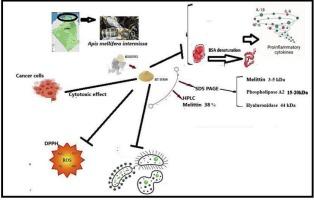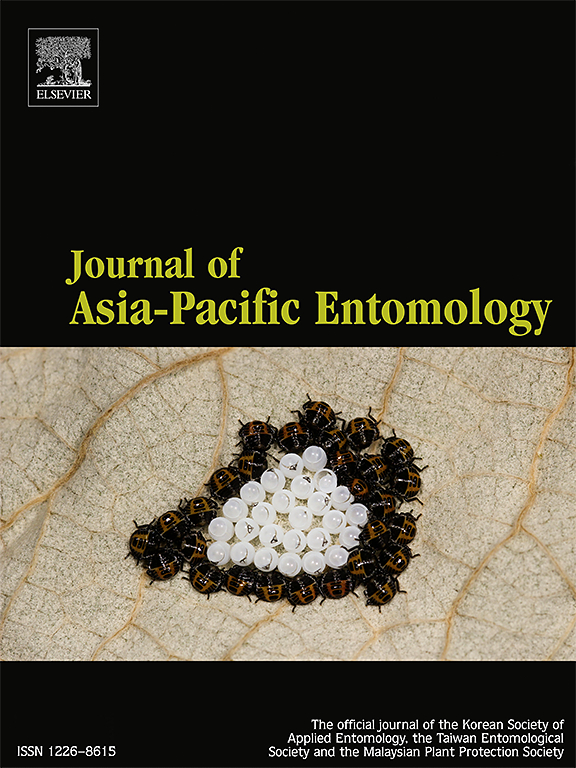Chemical, antioxidant, anti-inflammatory, antibacterial, and cytotoxicity assessments of Apis mellifera intermissa venom collected in Northeast Algeria
IF 1.3
3区 农林科学
Q3 ENTOMOLOGY
引用次数: 0
Abstract
This study characterized the venom of the Algerian honeybee, Apis mellifera intermissa, and evaluated its key biological activities. Biochemical analysis by High-performance liquid chromatography (HPLC) analysis revealed that melittin, the main component of bee venom, constituted approximately 38 % of its dry weight. Sodium dodecyl sulfate–polyacrylamide gel electrophoresis (SDS-PAGE) confirmed the presence of major components, including melittin (∼3–5 kDa), phospholipase A2 (∼15–20 kDa), and hyaluronidase (∼44 kDa). The venom exhibited strong antioxidant activity, as demonstrated by Ferric Reducing Antioxidant Power (FRAP) and 2,2-diphenyl-1-picrylhydrazyl (DPPH) radical scavenging assays. Potent, broad-spectrum antibacterial activity was observed against Pseudomonas aeruginosa, Klebsiella pneumoniae, Salmonella typhimurium, Enterococcus faecalis, and Acinetobacter baumannii, yielding low minimum inhibitory and bactericidal concentrations (MIC/MBC). The anti-inflammatory potential was evidenced by the inhibition of bovine serum albumin (BSA) denaturation. Furthermore, the venom exhibited significant cytotoxicity against MCF-7 and MDA-MB-231 human breast cancer cell lines, with half-maximal inhibitory concentrations (IC50) of 17.17 µg/mL and 11.90 µg/mL, respectively. These findings highlight venom as a rich source of bioactive compounds with multifaceted therapeutic potential for pharmacological development.

阿尔及利亚东北部采集的美洲蜜蜂毒液的化学、抗氧化、抗炎、抗菌和细胞毒性评价
本研究对阿尔及利亚蜜蜂(Apis mellifera intermissa)的毒液进行了鉴定,并对其主要生物学活性进行了评价。高效液相色谱(HPLC)生化分析表明,蜂毒的主要成分蜂毒素约占其干重的38%。十二烷基硫酸钠-聚丙烯酰胺凝胶电泳(SDS-PAGE)证实了主要成分的存在,包括蜂毒素(~ 3-5 kDa)、磷脂酶A2 (~ 15-20 kDa)和透明质酸酶(~ 44 kDa)。通过铁还原抗氧化能力(FRAP)和2,2-二苯基-1-吡啶肼基(DPPH)自由基清除实验证明,该毒液具有较强的抗氧化活性。对铜绿假单胞菌、肺炎克雷伯菌、鼠伤寒沙门菌、粪肠球菌和鲍曼不动杆菌具有广谱抗菌活性,且最低抑菌浓度(MIC/MBC)较低。抑制牛血清白蛋白(BSA)变性证明了其抗炎潜能。此外,该毒液对MCF-7和MDA-MB-231人乳腺癌细胞系表现出显著的细胞毒性,半数最大抑制浓度(IC50)分别为17.17µg/mL和11.90µg/mL。这些发现突出了毒液作为生物活性化合物的丰富来源,具有多方面的药理学治疗潜力。
本文章由计算机程序翻译,如有差异,请以英文原文为准。
求助全文
约1分钟内获得全文
求助全文
来源期刊

Journal of Asia-pacific Entomology
Agricultural and Biological Sciences-Insect Science
CiteScore
2.70
自引率
6.70%
发文量
152
审稿时长
69 days
期刊介绍:
The journal publishes original research papers, review articles and short communications in the basic and applied area concerning insects, mites or other arthropods and nematodes of economic importance in agriculture, forestry, industry, human and animal health, and natural resource and environment management, and is the official journal of the Korean Society of Applied Entomology and the Taiwan Entomological Society.
 求助内容:
求助内容: 应助结果提醒方式:
应助结果提醒方式:


